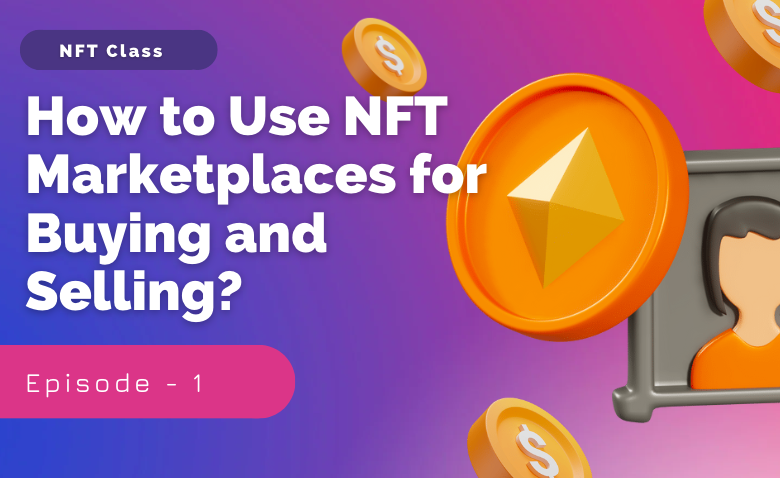Are you interested in learning more about NFTs and how they are altering the landscape of digital art and collectibles? NFT marketplaces have developed into a hub for buying and selling rare virtual goods as well as one-of-a-kind works of art. But with so many platforms available, navigating the environment may be intimidating. Don’t worry; in this article, we’ll walk you through NFT marketplaces’ ins and outs and provide you advice on how to maximize your buying and selling opportunities. So, fasten your seatbelts because we’re about to enter the fascinating realm of NFTs.
Overview of NFTs
NFTs are a type of digital asset that use blockchain technology to authenticate their uniqueness and ownership. They have exploded in popularity in recent years, with a wide variety of marketplaces offering platforms for buying, selling, and trading NFTs. From art and music to sports and gaming, NFTs are being used to create new markets and revenue streams for creators and collectors alike. As the NFT market continues to grow and evolve, it is sure to become an increasingly important part of the digital economy.
Types of NFT Marketplaces
With this new wave of interest in NFTs, there has been an emergence of different types of NFT marketplaces, each with its own unique features and benefits.
Primary marketplaces are the first places where NFTs are minted and sold, typically by the creator or original owner of the digital asset. These marketplaces are often curated and focused on specific niches or communities, allowing for a more targeted audience and a greater likelihood of success for the creators. Some popular primary marketplaces include SuperRare, Foundation, and Nifty Gateway.
Secondary marketplaces, on the other hand, allow for the buying and selling of already existing NFTs that have already been minted and sold on primary marketplaces. These marketplaces provide a platform for the secondary market, which allows for increased liquidity and an opportunity for investors to profit off the appreciation of NFTs. Examples of secondary marketplaces include OpenSea, Rarible, and NFTX.
Overall, the emergence of different types of NFT marketplaces reflects the growth and potential of the NFT market as a whole, providing creators and investors with new opportunities to monetize and invest in digital content.
Choosing an NFT Marketplace
With so many options available, choosing the right NFT marketplace can be a daunting task. We’ll explore some of the key considerations when choosing an NFT marketplace, popular marketplaces, and compare fees, user experience, and other factors.
- Firstly, it’s important to consider the type of art you want to sell or collect. Some marketplaces specialize in specific types of NFTs, such as digital art or music, while others offer a wider range of options.
- Another important consideration is fees. Different marketplaces will have varying fee structures, which can include transaction fees, listing fees, and platform fees. It’s essential to understand these fees and factor them into your pricing strategy, as they can significantly impact your bottom line.
- User experience is also a crucial factor when choosing an NFT marketplace. You’ll want to ensure that the platform is easy to use and navigate, and that it offers robust features to support your buying and selling needs. This can include features such as search and discovery tools, bidding systems, and analytics.
In conclusion, choosing the right NFT marketplace is an important decision that can have a significant impact on your success as a digital artist or collector. By considering factors such as the type of art, fees, user experience, and popular platforms, you can make an informed decision that aligns with your goals and values.
Buying NFTs on Marketplaces
Buying NFTs on marketplaces has become a popular way for collectors and enthusiasts to add these unique digital assets to their collections. Let’s go through the steps to buying an NFT and provide some tips to help you make the best purchase decisions.
Factors to Consider Before Buying an NFT
Before you dive into the world of NFTs, it’s important to consider a few factors that can impact your decision to buy.
Firstly, you need to consider the creator and the authenticity of the NFT. You want to make sure that the creator is reputable and that the NFT is legitimate. You can research the creator’s previous work and reviews to get an idea of their reputation.
Secondly, you should consider the rarity and value of the NFT. The rarer the NFT, the more valuable it is likely to be. You can also look at the historical sales data for similar NFTs to get an idea of their value.
Tips for Buying an NFT on a Marketplace
Now that you’ve considered the factors that can impact your purchase decision, here are some tips to help you buy an NFT on a marketplace:
- Choose a marketplace: There are many marketplaces to buy NFTs from, including OpenSea, Rarible, and SuperRare. You should choose a marketplace that has a good reputation and a wide variety of NFTs to choose from.
- Set a budget: NFTs can range in price from a few dollars to millions of dollars. It’s important to set a budget before you start browsing so that you don’t overspend.
- Research the NFT: Before buying an NFT, make sure you research it thoroughly. Look at the creator’s reputation, the rarity of the NFT, and the historical sales data. You can also check for any additional information about the NFT such as its usage rights, storage requirements, etc.
- Check the authenticity: You want to make sure that the NFT you’re buying is authentic. Look for a verification symbol on the NFT and check the blockchain to make sure that the NFT is not a fake.
- Be patient: NFT marketplaces can be fast-paced, and prices can change quickly. Don’t rush into buying an NFT just because you think it’s a good deal. Take your time and make sure you’re comfortable with the purchase.
By considering the factors that can impact your purchase decision and following these tips, you can make informed decisions and build a collection of unique digital assets that you can cherish for years to come.
Selling NFTs on Marketplaces
With the rise of NFTs, there has also been a surge in marketplaces where creators can sell their unique tokens to interested buyers. But with so many options available, it can be difficult to know where to start. Here are some steps and tips to help you successfully sell your NFT on a marketplace.
Factors to Consider Before Selling an NFT
Before you start the process of selling your NFT, there are a few key factors you should consider:
- Determine the Value of Your NFT: The first step in selling an NFT is to determine its value. This can be a difficult task, as there is no set formula for determining the worth of a unique digital asset. However, factors like the rarity of your NFT, the quality of the artwork or content, and the demand for similar tokens on the market can all play a role in determining its value.
- Choose the Right Marketplace: Once you have determined the value of your NFT, the next step is to choose the right marketplace to sell it on. There are many different marketplaces available, each with its own unique features, fees, and user base. Some popular options include OpenSea, Rarible, and Magic Eden.
- Understand the Fees: When selling your NFT on a marketplace, you will likely be charged a fee for each transaction. It’s important to understand these fees upfront, as they can vary widely between marketplaces and can impact the final price you receive for your token.
Tips for Selling an NFT on a Marketplace
Once you have considered the factors above and chosen a marketplace to sell your NFT on, there are a few tips you can follow to increase your chances of success:
- Create a Compelling Listing: When creating your listing on the marketplace, be sure to include a detailed description of your NFT, high-quality images or videos, and any relevant information about the creation process or backstory of the token. The more compelling your listing, the more likely buyers will be to take notice.
- Build Your Reputation: One key factor in selling an NFT on a marketplace is building a positive reputation. This can be done by participating in the community, engaging with other creators and buyers, and providing excellent customer service to those who purchase your tokens.
- Market Your NFT: While the marketplace itself can be a powerful marketing tool, there are other steps you can take to promote your NFT and increase its visibility. This might include sharing it on social media, reaching out to relevant influencers or blogs, or even creating a dedicated website or landing page to showcase your work.
In conclusion, selling an NFT on a marketplace can be a complex process, but by following these steps and tips, you can increase your chances of success and get your unique digital asset into the hands of interested buyers.
Conclusion
NFT marketplaces open up a whole new world of opportunities, whether you’re an artist trying to sell your work or a collector looking to add to your collection. You can successfully and confidently traverse the world of NFTs if you have the correct plan, information, and resources. So why not dive in and discover the fascinating world of NFTs right now? Who knows, you might stumble upon the upcoming masterpiece of digital art!

Neelam is a talented writer and financial analyst, currently studying at Hansraj College. She is a regular contributor to Trickyfinance, where she covers a range of topics including price prediction, stock market news, and market analysis. Neelam’s passion for finance and economics led her to pursue a writing career in the financial industry, where she has gained valuable experience and insights into the workings of the market. In her free time, Neelam enjoys reading and conducting her own market analysis to stay up-to-date with the latest trends and developments in the industry.




